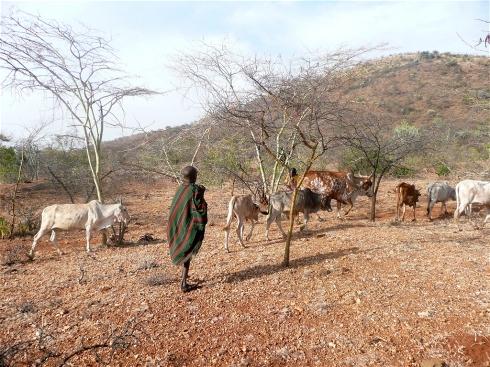IRIN
By Samuel Okiror
KAMPALA, 19 January 2016
At least 640,000 people in Uganda’s northeastern Karamoja region – more than half its population – are facing food shortages as a result of a drought-affected harvest.
Scaled-up food assistance for the semi-arid region will be needed in 31 out of 52 sub-counties over the next three months, according to a recent joint government and UN World Food Programme report highlighting conditions.

These households were “found to be heavily dependent on WFP assistance and coping by migrating to the green belts of the region, felling trees for firewood/charcoal and reducing the number of times and amounts of food eaten in a day,” it said.
This is the traditional lean season when food stocks are supposed to tide families over until the new harvest in March. But with little left in people’s stores, or money in their pockets, they are struggling.
The latest assessment by the USAID-funded Famine Early Warning Systems Network found that stores from last season’s below-average harvest were exhausted by early December. “With the depletion of food stocks, some households in [five out of seven] districts have moved from stressed to crisis in December,” said FEWS NET.
In two districts – Moroto and Kaabong – one fifth of all people are currently in “crisis”, and will remain so until March. A “crisis” classification means households are missing meals or just meeting their minimum food needs through a fire sale of their animals – a “negative coping strategy” that drives families deeper into poverty.
“The situation is really bad. The government and WFP are not doing much on the ground to rescue and save the lives of the people. The assistance so far is not enough,” Samson Lokeris, chair of the Karamoja Parliamentary Group, told IRIN.
“[The poor] are surviving on eating residue [left after the brewing of beer] and going for wild fruits,” he said. “If there is no immediate intervention, we are going to experience several deaths in the region due to starvation and hunger. We need immediate attention from [the] government and WFP.”
Karamoja has the worst human development indicators in the country. The semi-nomadic pastoralist region is increasingly prone to climate extremes, experiencing a four-year stretch of “dry spells” beginning in 2006. There were local media reports of hunger-related deaths as a result of last year’s drought.
Aid response
“The government is aware and acting to address the deteriorating situation,” Musa Ecweru, Uganda’s state minister for relief and disaster preparedness, told IRIN. “We are making interventions and responding to the crisis by sending emergency relief food.”
WFP began scaling up its assistance to the region in December.An estimated 300,000 people will be helped with additional food distributions, or provided with a bigger basket of food items under an asset-support programme.
“In addition, using funds contributed earlier by the UK, WFP will provide a ration of cereals, pulses, and oil to 67,500 people in households with children, pregnant women and new mothers affected by acute malnutrition,” Michael Dunford, WFP country director, told IRIN. WFP will also continue to provide free school meals to all schools in the region.
Is it enough?
The extent of Karamoja’s poverty is underlined by its malnutrition rates. A WFP and UNICEF survey in June found Global Acute Malnutrition at critical levels in four districts, with the worst figures in Moroto and Napack, at 18.3 percent and 16.2 percent respectively. The emergency threshold is 15 percent.
But why are Karamoja’s problems so entrenched?
WFP provided emergency food aid annually to the region for more than 40 years until 2012, when it scaled back its operation to provide more targeted, voucher, and cash-based assistance. The shift away from dependency-generating food relief was in line with the government’s Karamoja Action Plan for Food Security (KAPFS) and the World Bank-funded Northern Uganda Social Action Fund.
The strategy identified the centuries-old tradition of pastoralism as the problem behind the region’s underdevelopment, and sought to prioritise crop farming and settlements so that services could be brought to the people and new jobs encouraged.
But in a 2010 report, researcher Simon Levine noted: “Development policy which favours encouraging settlement is, perversely, creating artificial disaster emergencies or artificial droughts; because it creates a situation where households can no longer survive independently when the rains are poor, which did not exist when households could survive from their livestock.”
Policy muddle?
The government’s $35 million five-year-long KAPFS is widely seen as a failure in building resilience or sustainable livelihoods – especially when confronted by a drying climate. Alternative opportunities like small-scale mining have proven highly exploitative, according to a Human Rights Watch report.
See: Questions over Karamoja food security plan
“Agriculture on the side of crop farming cannot be relied upon since most agricultural systems of crop farming in Karamoja are rain-fed. [The] Karamoja problem can only be solved by restocking the region with livestock, according to the ecological demands of the region,” said Pius Loupa, a project officer on conservation agriculture from the Dodoth Agro-pastoralists Development Organisation, in Kaabong District.
“The government should accept Karamoja as a pastoralist community, thereby formulating pastoralist and agro-pastoralist policies. Forcing people onto agriculture will never succeed.”
The extent of that failure is the increasing calls for WFP to abandon targeted feeding and return to generalised food hand-outs in response to the current crisis.
“We call on WFP to change its policy and feed all the people in Karamoja. We need to save lives. If it doesn’t change people are going to starve and die. It shouldn’t be helping only lactating mothers, elderly, and children alone, ignoring the rest of the people who are starving,” said Lokeris, the parliamentary group chair.
“People can’t afford to buy food in the markets because of the high prices. The situation has forced people to move to Sudan and Kenya to look for food and pasture for their animals.”
Samuel Okiror
IRIN is an independent, non-profit media organization

